How to do SEO in Ecommerce?
If you want to do SEO for ecommerce and position your store in Google, you must follow these steps:
- Acquire the security certificate or SSL.
- Prioritize the best performing pages.
- Do an analysis of keywords per page by choosing the main mother keyword + derivatives (specific).
- Optimize all tags and page titles.
- Add structured data.
- Develop a content marketing strategy that drives traffic to your store.
Ecommerce, or virtual stores, have become an attractive solution for companies. The problem is that after they build these complex websites, the traffic and sales they generate is low.
Why does this happen?
Because, just like in the offline world, when you are a small startup or brand you always start out at a disadvantage next to the big corporations.
The same products that you sell are also offered by super-recognized brands that have high domain authorities and good positions for key phrases with high monthly search volume.
Let’s look at an example:
Let’s say you’re a power tool store in the United States.
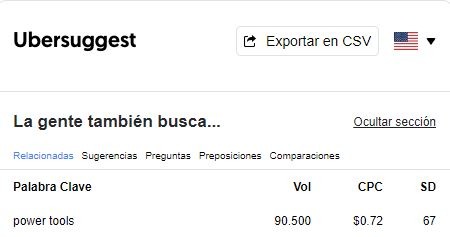
According to Ubersuggest, this is a query with 90,500 searches per month.
You must be thinking, “Wow, I have a chance of attracting quite a few people.”
The detail is as follows:
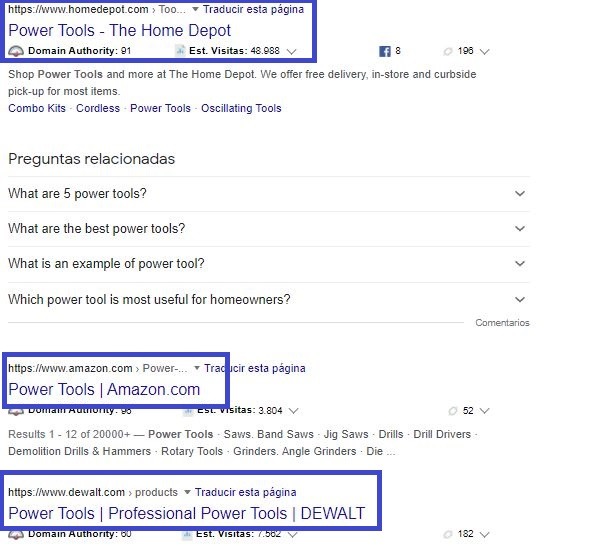
Unless you are a company of this caliber, I am sorry to tell you that you will have no chance of dethroning them.
The dream of attracting those 90 thousand monthly searches, then, dies
This is where SEO comes in.
What is SEO?
The acronym SEO refers to Search Engine Optimization, which in Spanish translates as optimization for search engines.
Also known as search engine optimization, SEO is about creating content and improving your website to make it as attractive as possible to both Google and your potential customers.
If you want to know how this whole branch of marketing works, you can click here: What is SEO?: How does web positioning work?
You must take advantage of this tool to dominate less competitive territories where you have opportunities to win.
Let’s start.
Acquire the security certificate or SSL
It is important that your website has the security certificate or SSL.
SSL stands for “Secure Sockets Layer” (secure transport layer).
Security certificates can be obtained and purchased in different ways, either through a hosting service or in a company dedicated to it.
Even if you already have one, it is important to verify your security certificate or SSL in order to validate it and protect the data transfer with your domain.
As we explained in our article How to create an SEO website? , TLS or SSL certificates are a key and a shield: they secure your website data in the chest of your server and protect your site from malicious users or “hackers” in the browser.
Because they are important?
Because they declare to search engines confidentiality, integrity and authentication.
In Spanish, your website needs to have the famous “padlock” when people are browsing it.

Ecommerces request and store personal information and bank details. Neither Google nor users will trust your company unless you assure them that you are a secure website.
Having this lock is also considered a ranking factor by the search engine
Prioritize the best performing pages
Probably, when you read that you had to perform a keyword analysis per page , you thought that it would take a lot of time.
“How am I going to individually analyze the thousands of product pages I have?”
If you want to get the best results, you should do it.
That is why we will prioritize the pages to go from the most important to the least important.
How?
There are 2 options:
- Filter in Google Search Console the best positioned product pages.
- Filter in Google Analytics the pages with the best income or sessions.
Filter in Google Search Console the best positioned product pages
Enter your GSC account and make the following clicks:
Performance > Last 6 months > New > Page > Product Page URLs > Apply.
You should have something like this:


Export this list in the format of your choice (Google spreadsheets or Excel) and you will have the pages that have had the best organic performance organized by number of clicks.
Filter in Google Analytics the best positioned product pages
If your store is already generating some sales, this is probably the most recommended option.
Enter your Google Analytics account and make the following clicks
Behavior > Site Content > Landing Pages.
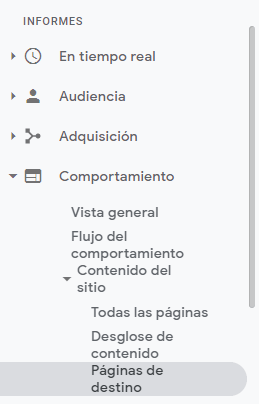
ProTip: remember to customize the period of time you deem necessary. At Pencil Speech we believe that with 6 months you can see a fairly complete panorama of trends and patterns that your website has.

Export your list again in the format of your choice and you can start working.
Keyword analysis per page – Long tail strategy
Now that you have the first pages that you are going to work with, it is time to start investigating how to position them.
For each page we must determine:
- Keyword focus or main keyword.
- Long tail variants that are related to the main keyword.
Choose the main keyword
We must investigate for which keywords that page is already positioned.
We will do this with Google Search Console and it will allow us to know three things.
- What Google considers as the main topic for our page.
- How many impressions we’re getting for that topic (search volume).
- Where do we stand on that topic?
Repeat the previous step and select the page to optimize.
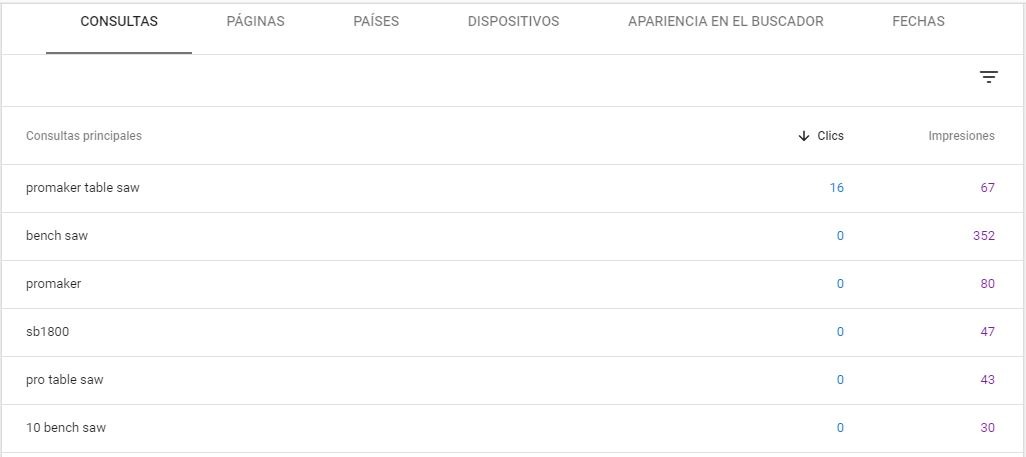
Here you will see the queries for which that page is already receiving clicks and impressions.
Continuing with our example of tools in the United States, we see that the “bench saw” query is the one that has generated the most impressions, that is, the one that has the most search volume.
Since this is the global name of a tool, it works perfectly to choose it as the main keyword and optimize the page around that query.
ProTip: Create another Google spreadsheet to keep track of the pages you optimize and the keywords and variants you choose.

Now you need to do a Google search to investigate the Google search results page (SERP) and find out the following:
- Which companies, and with which pages, are positioned in the first positions.
- What is the search intent behind the results Google is ranking: Are they product pages? Are they blog posts explaining which are the best bench saws? Explanatory videos giving reviews of different brands?
With this investigation you will determine if you are fulfilling the intention that users have and, therefore, if your page can dethrone those who are first.
Let’s do the test:
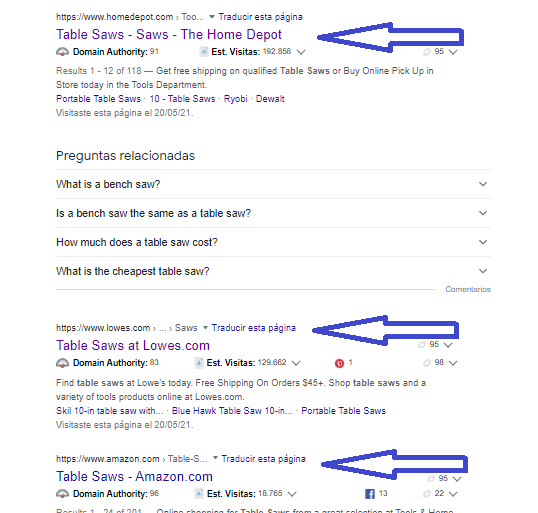
- The early results are dominated by large companies: Home Depot, Lowes and Amazon. Here it will be almost impossible to dethrone them.
- When searching for “bench saw” Google is showing results from pages titled “table saw”, so our main keyword must change to this second variant. This conclusion is important because if we leave our page titled with “ bench” , instead of “ table” , we will never stand a chance.
- The positioned pages are products, that is, the intention behind this query is clearly a purchase. With a different type of content, like an article talking about the best bench saws, we are not going to attract traffic.
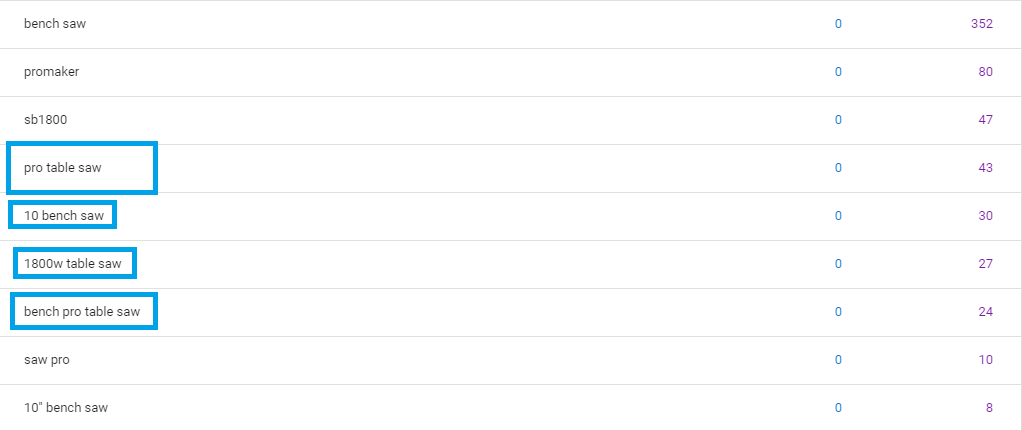
Observing the options, we can choose the following alternatives:
- pro table saw
- 10 bench saw
- 1800w table saw
- bench pro table saw
These are all product features that we need to add in our page tags to position ourselves in these less sought after realms.
ProTip: Add these variants to your spreadsheet to keep track

Now, just like in the previous point, we need to investigate the Google results page for each variant.
Look again at who is ranking and what type of content they are using.
Repeat this process with each of the prioritized pages to be optimized🙂
SEO On Page for Ecommerce
SEO On Page consists of adjusting the packaging of your website to make it easier and friendlier to read, both for search engines and for Internet users.
We must optimize our tags with the keywords we chose so that Google takes us into account in the new areas to be conquered.
Optimize title tags, meta tags and H1s
It is normal for ecommerce, having a large number of pages, to use a template technique or “template” for all the titles and descriptions of their pages.
Example: Product name – Unique value proposition – Brand name.
Although this strategy can be effective at the beginning to have an order on the web, it will not help us to obtain optimal positioning with each product.
The ideal scenario is to have unique tags on each page, but going by the 80/20 principle (80% of results come from 20% of effort) we can end up with a mixed approach.
That is, a template that will allow each package to have unique names and value propositions.
Example : main keyword + long tail variants – Unique value proposition – Brand name*
In some occasions we will need to prioritize between the USP and the brand name to have the correct length for Google.
ProTip: To make sure you write title tags and meta tags with the correct lengths, you can use plugins like YoastSEO or RankMath (in case you use WordPress as your CMS).
Let’s continue with our tool store example to see this in practice.
We know we should add the main keyword, table saw, and its variants: pro table saw, 10 bench saw, 1800w table saw, bench pro table saw.
So, in the end, we end up with something like this:

Here we are using the “template” with the main keyword and its variants, call to action and brand name.
The second half of the packaging (CTA and brand name) can stay that way for all product pages, while the first half (keywords) should be unique to each page.
The H1 or internal title of the page should only be the name of the product, without embellishments and without trying to attract people with some flashy adjective.
With only the name you will be doing the right job.
Optimize the URLs
Product page URLs must meet the following criteria:
- Contain the main keyword of the page.
- Indicate the correct route to reach this page within the website.
That is, the logical path of your website must be the same as indicated by the URL on the page.
For example:
- Domain/product category page/product.
- Domain/product page/product.
- Domain/language/product category page/product.
- Domain/language/product.
The options are plentiful, but in the end the formula is the same: keep your URLs in a logical order.
Messy URLs won’t let Google prioritize or understand the structure of the site.
Here the sitemaps that are uploaded to Google Search Console will be quite important. Check that they do not have errors and that the pages are ordered in each file that is uploaded.
Structured Data for Ecommerce
Structured data helps Google to perfectly understand what your pages are about and also shows additional information to the user.
Adding this data can increase your CTR by up to 30% .
Structured data helps tell Google if our page is a:
- Article.
- Product.
- Recipe.
- Book.
- Tutorial.
The number and variety of structured data that can be aggregated today are vast.
This is the way in which the search engine understands what we offer as if it were also a human.
If you want to know more about this data, click here: Rich snippets and structured data in Google
Let’s see how this data is displayed on the Google results page:
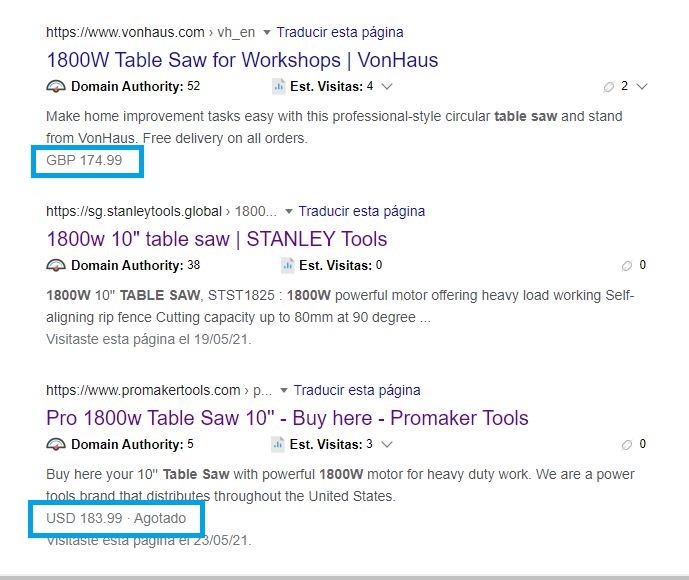
Notice how the first and third results show the price and also, in the third we can see the availability of the product.
These are the type of “tracks” that increase our CTR.
Mandatory data or properties to add
There is a field that, just because, you must add:
Text/Name: It is the name that identifies the product.
It must also be accompanied by at least one of these three properties:
- Review: criticism of the product by users.
- AggregateRating – The average rating of the product.
- Offers: current offer.
Data or recommended properties (optional)
These are some fields that you can complete in that technical sheet of your product for Google
- manufacturer’s mark
- Short description of the product with the main functionalities.
- Image
- Price (required for offers).
- Coin.
- gtin8 | gtin13 | gtin14 | mpn | isbn*.
- Availability.
- Sku.
- Item offered.
- Price valid until.
- Url.
*The Global Trade Item Number (GTIN) is used to uniquely identify a product or service. The GTIN identifies product types at any level of packaging (for example, consumer unit, inner pack, case, dunnage).
Verify structured data in Google Search Console
To confirm that the structured data has been added correctly, inspect the URLs individually in the Google Search Console.
If the search engine has correctly crawled the page, it will show you the data it reads and the warnings with those data that you need to add.
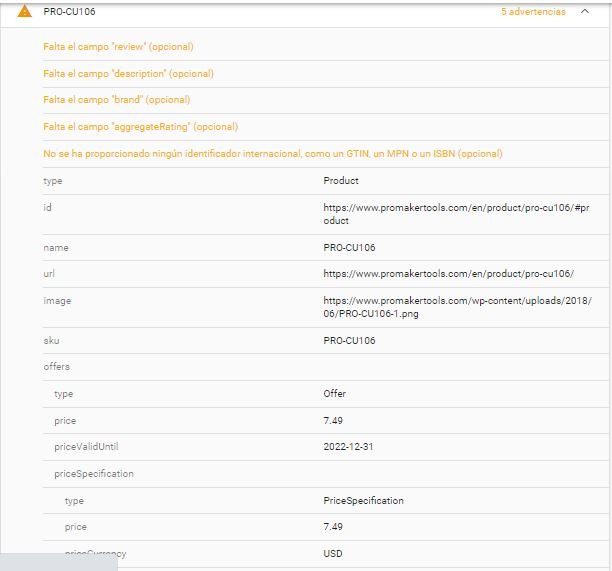
Content Marketing for Ecommerce
Although this step is almost at the end of the article, it can be done in parallel to everything mentioned above.
Content marketing will be what:
- It will grow your domain authority on the internet.
- It will keep your ecommerce with enough traffic to make it a profitable investment.
Writing the best pieces of content is the only way to become an authoritative voice within any industry.
Items may be accompanied by:
- Videos.
- Infographics.
- Downloadable templates.
- Resources.
But, in the end, the text will be paramount.
You should not only write about your industry in general, but about the niche in which you develop and know better. You must answer all the questions and solve all the problems that people may have regarding your product or service.
At Pencil Speech we have always promoted, used and evangelized the strategy proposed by Marcus Sheridan in They Ask, You Answer .
Sheridan explains that before making a purchase decision, people always look for all topics in the same 5 ways, the famous “Big Five”:
- Prices.
- Problems.
- Best in class.
- Reviews.
- Comparisons.
How does this look in practice?
- Prices : What are the variables that affect the prices of power tools?
- Problems : Why is it not advisable to buy X tool?
- Best in Class : The 10 best tools to have in a workshop.
- Comparisons : Table saw vs Chainsaw.
- Reviews: Testimonials should be on your website and on your product pages.
Take a pen and paper, write down all the questions your customers have ever asked you and turn them into articles that your audience can get on Google and read on your website.
Final considerations
This guide covers 90% of everything you need to know to rank your ecommerce or product pages on Google.
In addition to this, it will always be useful to carry out link building strategies and be attentive to internal linking within the website.
If you follow the above strategies, you will find yourself at the advantage of many ecommerce within your industry.
Do not hesitate to comment on any questions you have about this topic and keep in mind that at Pencil Speech we can help you do everything explained in this article.



